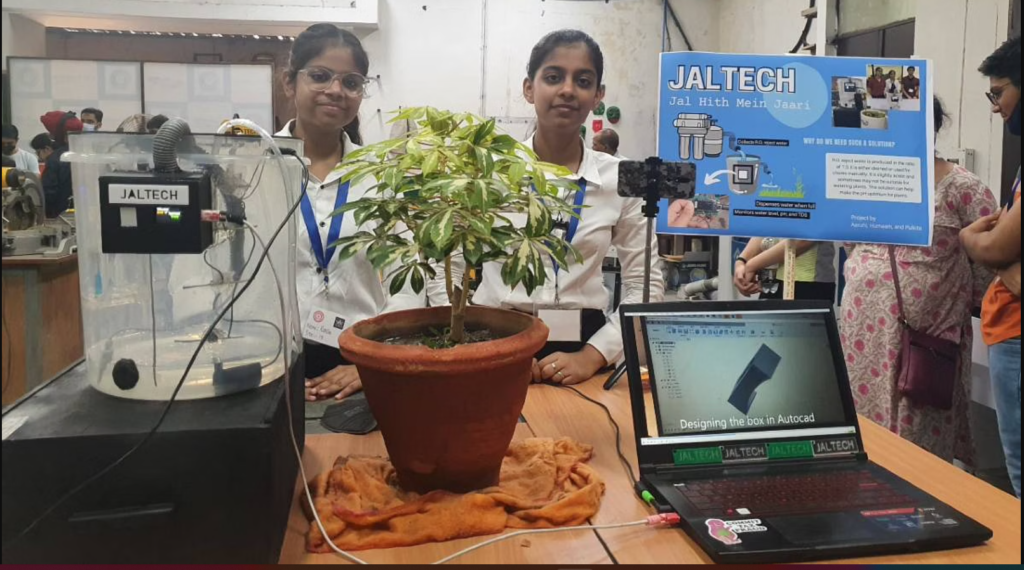25 school students selected by IIT-Delhi for a five-week ‘Change.Makers’ bootcamp have come up with some promising solutions for common problems.
New Delhi: Mrinalini Singh, a Class 12 student of St Xavier’s School in Delhi, is over the moon. She and a fellow student have created a prototype of a wand-like ‘Trekker’s Safety Device’ as part of a bootcamp at Indian Institute of Technology – Delhi (IIT-D). The device, which can transmit a low-frequency SOS signal whenever a trekker gets lost, has been termed “promising” by the director of the institute, Prof Rangan Banerjee.
“Our prototype was praised by the director of IIT-D as being of use to the Indian Army. He even asked our mentor to show it to the Defence Research and Development Organisation,” an elated Mrinalini told ThePrint.
She was among the 25 school students from across India selected by IIT-D for a five-week ‘Change.Makers’ bootcamp organised at the institute’s Makerspace. The students showcased their prototypes on Friday, when the camp ended.
Makerspace is a Do-It-Yourself facility at IIT-Delhi, equipped with machines such as laser-cutters, waterjet-cutters, CNC routers, 3D printers, PCB prototyping stations, soldering stations, welding kits, and various hand and power tools.
The first-of-its-kind bootcamp, open to students of class 11 and 12 studying science, was aimed at honing the skills and ideas of “change-makers” of the future. According to professors at the institute, the process of selection for the bootcamp was rigorous and they were not just looking for students with a scientific bent of mind, but also those who could think like change-makers.
At the bootcamp, the students were given tours of different research labs at the institute where they got to interact with leading researchers in the science and technology disciplines.
“It was fascinating to see the enthusiasm, ideas and initiative among the young students. We hope to enthuse school children to learn by solving societal problems,” Prof Banerjee said in a press statement.
Prof Jay Dhariwal, the coordinator of the bootcamp and in-charge of Makerspace, called it “an enriching experience for students and faculty alike”.
“We selected students who had knowledge of the basic science required and who had the willingness to bring a change with their innovation. These students have undergone rigorous training in order to ideate and create these prototypes,” he said.
The prototypes
Students at the camp formed nine teams and developed nine prototypes relating to rehabilitation exercise monitoring, automating reuse of filtered water, aeroponics, trekker safety, quadruped terrain-mapping robot, avoiding drowsiness in drivers, stretcher convertible seats in vehicles, real time text-to-braille translator, and a rolling robot.
Talking about the ‘Trekker’s Safety Device’, Mrinalini said that it can transmit a low-frequency SOS signal whenever a trekker gets lost. A remote receiver placed with the forest or rescue authority will receive the geolocation of the trekker sending the SOS call.

She explained: “The signal is sent on a particular bandwidth using an unlicensed frequency. The device that we have created transforms the signal into a code which is converted into the longitude and latitude of the trekker and sent to the rescue team.”
Another project at the bootcamp was a rolling robot — which can be used to rescue people stuck in flooded areas — created by 16-year-olds Rishabh Raj and Jay Singh.
The spherical robot can be controlled via an app on the phone, and the camera on the robot shows real time status of the area in distress.
Jay, a Class 12 student, told ThePrint: “As of now, we have created this robot for less than Rs 15,000 in this lab. We got to learn a lot from the professors here and we now aim to reduce the cost of this prototype by half.”
The challenge for the duo is to overcome the phone network issues that the device may face in remote regions. On this, they said, it can be converted into a device that receives signal from satellites. But they would need better funding to pull that off.
Another group at the camp, Jaltech, aimed to overcome the water wastage of home water-purifiers. They created a filtration pod which not only stores the waste water, but also reduces its pH value so that it can be used to water plants.
Humaam, another Class 12 student part of the Jaltech project, said: “During the first week at the bootcamp, we looked at the areas of a household where water is wasted. We realised that the home water-purifiers filter water at a 3:1 ratio, meaning 3 litres of water is wasted for every 1 litre purified.”
“We then looked for a way to make this water usable. We have put a borax filtration system in our pod that identifies the acidity of the water and makes it usable again,” he added.
The next challenge for the students is scalability of their respective prototypes, as they will now have to seek external funding to develop their devices into industry-use models.
Article Credits: The Print
